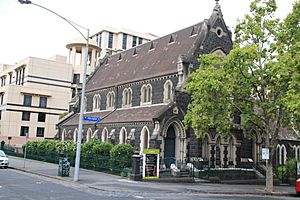Lutheran Trinity Church, East Melbourne facts for kids
Quick facts for kids Lutheran Trinity Church |
|
|---|---|

Church in 2012, with hall on right
|
|
| Location | 22 Parliament Place, East Melbourne, Victoria, Australia |
| Lua error in Module:Location_map at line 420: attempt to index field 'wikibase' (a nil value). | |
The Lutheran Trinity Church is a special old church located in East Melbourne, Australia. It's a Lutheran church, which means it belongs to a specific Christian group. This beautiful building was finished in 1874. It's so important that it was added to the Victorian Heritage Register on October 9, 1974, meaning it's protected because of its history and design. You can find it on Parliament Place, close to other important buildings like St Patrick's Cathedral and Parliament House. Many of the church services here are still held in German.
Contents
The Church's Story
Early Days and First Building
The story of the Lutheran Trinity Church began a long time ago. The first church building was completed in 1854. This original church was later replaced by the larger, more beautiful building you see today in 1874.
In January 1853, the church was given a piece of land in East Melbourne. This land was about half an acre, which is like half a football field. People donated money, the government helped, and a bank loan covered the costs.
The first stone for the church was laid on September 27, 1853. The completed church was officially opened on June 11, 1854. A bit later, in February 1855, more land was given for the manse, which is the house where the church's pastor lives.
Building the New Church
By 1870, people started talking about making the church bigger. They also needed to do some repairs. Selling some of the church's land helped them get money for a brand new building.
The first stone for the current church was laid on March 17, 1874. The new, completed church was officially opened on November 22, 1874.
Who Designed the Church?
John Koch, an architect and a member of the church committee, started making plans for the second church. However, another architect named Carl Blackmann offered to design the church for free.
Blackmann, also known as Charles Blachmann, sent his plans, and they were accepted. John Koch later designed the manse, which was built in 1890.
Early Pastors
The first pastor of the church was Matthias Goethe. He was appointed on March 25, 1853. Later, Hermann Herlitz became the pastor. He served the church for a very long time, from 1868 until 1914.
What the Church Looks Like
Outside the Building
The Lutheran Trinity Church is built from a dark grey stone called bluestone. It has a roof made of slate tiles that slopes steeply. The building's design is like a basilica, which is a traditional style for churches.
The outside of the church is about 90 feet long and 42 feet wide. Inside, the ceiling reaches up to 46 feet high at its highest point. The church was designed to hold between 370 and 500 people.
Inside the Building
Inside the church, on each side, there are five pointed arches. These arches have special shapes and designs. They separate the aisle, which is the walkway, from the nave, which is the main part of the church where people sit.
These arches are held up by columns. The tops of these columns, called capitals, are decorated with designs that look like leaves and plants.
Why the Church is Important
Heritage Protection
The Lutheran Trinity Church, along with its hall, the pastor's house (manse), the fences, and the land, were all added to the Victorian Heritage Register on October 9, 1974. This means they are protected because they are very important to Victoria's history and culture.
The church is special because its congregation has been using this site continuously since 1853. Also, church services have almost always been held in German. As of 2025, there is an English-language service held on the fourth Sunday of each month, with German services on other Sundays.
Architecture and Art
The bluestone church is also important for its beautiful architecture. Inside, it has rich decorations, including a wooden ceiling. The stained glass windows, which are colorful and artistic, were made by a company called Ferguson and Urie.
The Pipe Organ
A large musical instrument called a pipe organ was officially dedicated in the church on May 16, 1875. This organ is very important because it was built by Robert Mackenzie. Even though it has been rebuilt twice over the years, it still has its original pipes and outer case.
See also

